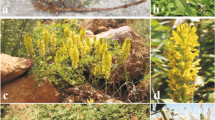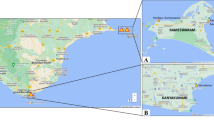Abstract
Background
Cancer is one of the most important reasons for mortality worldwide. Several synthetic products have shown valuable efficiency as an anticancer medicines. Chromene derivatives have long been used as the promising compounds which are potent in inhibition of the growth of tumors.
Methods and results
In this study, we investigate an anticancer activity of barbituric/thiobarbituric acid-based chromene derivates. For this purpose, viability, antioxidant and apoptotic assays were conducted using three different cancer cell lines (A2780, MCF7, and A549). In most cases, the antiproliferative activity of barbituric acid-based derivatives was higher than that of thiobarbituric acid-based compounds. Among 14 compounds, compound 4g was the most potent one, which showed the highest effect on cells by increasing the accumulation of ROS (up to 540% increase), increasing the level of caspase-3 and caspase-9 (~ 35% increase), and decreasing the mitochondrial membrane potential (2.5 folds reduction). To characterize the type of cell death involved into our experiment Annexin V/PI double staining of compound 4g was performed. The results showed that the number of late apoptotic and/or necrotic cells (Ann V + /PI +) increased fourfold upon treatment with IC50 concentration of 4g.
Conclusions
Overall, the anti-proliferative activity of barbituric acid-based derivatives was higher than that of thiobarbituric acid compounds, and compound 4g can be introduced as a potential candidate to prevent various cancers.




Similar content being viewed by others
Data availability
The datasets generated during and/or analysed during the current study are available from the corresponding author on reasonable request.
References
Siegel RL, Miller KD, Jemal A (2020) Cancer statistics, 2020. CA A Cancer J Clin 70:7–30. https://doi.org/10.3322/caac.21590
Cavalli G, Heard E (2019) Advances in epigenetics link genetics to the environment and disease. Nature 571:489–499
Anand P, Kunnumakara AB, Sundaram C, Harikumar KB, Tharakan ST, Lai OS, Sung B, Aggarwal BB (2008) Cancer is a preventable disease that requires major lifestyle changes. Pharm Res 25:2097–2116
Nenclares P, Harrington KJ (2020) The biology of cancer. Medicine 48:67–72. https://doi.org/10.1016/j.mpmed.2019.11.001
Rawla P, Sunkara T, Gaduputi V (2019) Epidemiology of pancreatic cancer: global trends, etiology and risk factors. World J Oncol 10:10
Sasieni P, Castanon A, Parkin DM (2009) How many cervical cancers are prevented by treatment of screen-detected disease in young women? Int J Cancer 124:461–464
Faguet GB (2015) A brief history of cancer: age-old milestones underlying our current knowledge database. Int J Cancer 136:2022–2036
Chen Y-L, Chang M-C, Cheng W-F (2017) Metronomic chemotherapy and immunotherapy in cancer treatment. Cancer Lett 400:282–292
Carter SK, Bakowski M, Hellman K (1987) Chemotherapy of cancer, 3rd edn. Wiley, USA
Mohammad A, Mehdi K, Ali R, Saeed E, Abdolhossein Z, Omidreza F, Ramin M, Abbas S (2013) 2H-chromene derivatives bearing thiazolidine-2,4-dione, rhodanine or hydantoin moieties as potential anticancer agents. Eur J Med Chem 59:15–22. https://doi.org/10.1016/j.ejmech.2012.10.044
Ahmed HH, Mahmoud ME, Ahmed MEK, Ahmed MAIAE-H, Hassein AE, Ahmed ME-A (2017) Anticancer activities, molecular docking and structure–activity relationship of novel synthesized 4H-chromene, and 5H-chromeno[2,3-d]pyrimidine candidates. Med Chem Res 26:2624–2638. https://doi.org/10.1007/s00044-017-1961-3
Shivaputra AP, Jin W, Xiaochen SL, Jianjun C, Terreia SJ, Amira H-A, Renukadevi P, William LS, Wei L, Duane DM (2012) New substituted 4H-chromenes as anticancer agents. Bioorg Med Chem Lett 22:4458–4461. https://doi.org/10.1016/j.bmcl.2012.04.074
Alideertu D, Yue S, Shi L, Qin W, Qian C, Xiuzhen Q, Yanling Z, Ge G, Fengqi L, Chokto H (2013) Barbituric acid-based magnetic N-Halamine nanoparticles as recyclable antibacterial agents. ACS Appl Mater Interfaces 5:8125–8133. https://doi.org/10.1021/am402191j
Palwinder S, Matinder K, Pooja V (2009) Design, synthesis and anticancer activities of hybrids of indole and barbituric acids—Identification of highly promising leads. Bioorg Med Chem Lett 19:3054–3058. https://doi.org/10.1016/j.bmcl.2009.04.014
Mohamed AAR, Eman AR, Nermien MS, Siham ME-S (2007) Synthesis and biological evaluation of new 3-substituted indole derivatives as potential anti-inflammatory and analgesic agents. Bioorg Med Chem 15:3832–3841. https://doi.org/10.1016/j.bmc.2007.03.024
Ghadami SA, Shevidi S, Hosseinzadeh L, Adibi H (2020) Synthesis and in vitro quantification of amyloid fibrils by barbituric and thiobarbituric acid-based chromene derivatives. Biophys Chem 269:106522. https://doi.org/10.1016/j.bpc.2020.106522
Reddy BVS, Divya B, Swain M, Rao TP, Yadav JS, Vardhan MVPSV (2012) A domino Knoevenagel hetero-Diels–Alder reaction for the synthesis of polycyclic chromene derivatives and evaluation of their cytotoxicity. Bioorg Med Chem Lett 22:1995–1999. https://doi.org/10.1016/j.bmcl.2012.01.033
Refat HM, Fadda A, Kamal S (2014) Synthesis and antitumor evaluation of some new biscarboxamidocoumarin and chromene derivatives. J Iran Chem Soc 12:845–854. https://doi.org/10.1007/s13738-014-0547-y
Reddy KR, Rao PS, Dev GJ, Poornachandra Y, Kumar CG, Rao PS, Narsaiah B (2014) Synthesis of novel 1,2,3-triazole/isoxazole functionalized 2H-Chromene derivatives and their cytotoxic activity. Bioorg Med Chem Lett 24:1661–1663. https://doi.org/10.1016/j.bmcl.2014.02.069
Samira R-N, Maliheh S, Mahboobeh P, Sussan Kabudanian A, Leila K, Yaghoub P, Mohammad M, Saeed E, Alireza F, Abbas S (2014) Synthesis, in vitro cytotoxicity and apoptosis inducing study of 2-aryl-3-nitro-2H-chromene derivatives as potent anti-breast cancer agents. Eur J Med Chem 86:562–569. https://doi.org/10.1016/j.ejmech.2014.09.017
Arjomandi OK, Almasi S, Hosseinzadeh L, Kavoosi M, Adibi H (2020) Preparation, characterization and in-vitro biological evaluation of novel curcumin derivatives as cytotoxic and apoptosis-inducing agents. Anticancer Agents Med Chem. https://doi.org/10.2174/1871520620666201002111205
Hosseinzadeh M, Vafa MR, Esmaillzadeh A, Feizi A, Majdzadeh R, Afshar H, Keshteli AH, Adibi P (2019) Psychological disorders and dietary patterns by reduced-rank regression. Eur J Clin Nutr 73:408–415. https://doi.org/10.1038/s41430-019-0399-8
Zheng TS, Hunot S, Kuida K, Momoi T, Srinivasan A, Nicholson DW, Lazebnik Y, Flavell RA (2000) Deficiency in caspase-9 or caspase-3 induces compensatory caspase activation. Nat Med 6:1241–1247
Frei E, Elias A, Wheeler C, Richardson P, Hryniuk W (1998) The relationship between high-dose treatment and combination chemotherapy: the concept of summation dose intensity. Clin Cancer Res 4:2027–2037
Chari RV (2008) Targeted cancer therapy: conferring specificity to cytotoxic drugs. Acc Chem Res 41:98–107
Chabner BA, Roberts TG (2005) Chemotherapy and the war on cancer. Nat Rev Cancer 5:65–72
Oliva A, De Cillis G, Grams F, Livi V, Zimmermann G, Menta E, Krell H-W (2002) Barbituric acid derivatives with antimetastatic and antitumor activity. Google Patents
Laxmi SV, Rajitha G, Rajitha B, Rao AJ (2015) Photochemical synthesis and anticancer activity of barbituric acid, thiobarbituric acid, thiosemicarbazide, and isoniazid linked to 2-phenyl indole derivatives. J Chem Biol 9:57–63. https://doi.org/10.1007/s12154-015-0148-y
Narsimha Reddy P, Amit K, Konjeti RS, Michael LF, Robert LE, Ramesh B, Peter AC (2015) 1-Benzyl-2-methyl-3-indolylmethylene barbituric acid derivatives: Anti-cancer agents that target nucleophosmin 1 (NPM1). Bioorg Med Chem 23:7226–7233. https://doi.org/10.1016/j.bmc.2015.10.019
Priyanka B, Manoj K, Anjali J (2018) Design, synthesis and anticancer evaluation of oxa/thiadiazolylhydrazones of barbituric and thiobarbituric acid: a collective in vitro and in silico approach. ChemistrySelect 3:7060–7065. https://doi.org/10.1002/slct.201800832
Maria Teresa C, Cenzo C, Valentina O, Riccardo P (2001) Synthesis and antitumor evaluation of 6-thioxo-, 6-oxo- and 2,4-dioxopyrimidine derivatives. Il Farmaco 56:741–748. https://doi.org/10.1016/s0014-827x(01)01123-5
Pfeffer CM, Singh ATK (2018) Apoptosis: A Target for Anticancer Therapy. Int J Mol Sci 19:448. https://doi.org/10.3390/ijms19020448
Ghazi-Khansaria M, Mojarrab M, Ahmadi F, Hosseinzadeh L (2013) The antiproliferative effects of petroleum ether extract of Artemisia aucheri on human cancerous cell lines. J Rep Pharm Sci 2:61–66
Tandon VR, Sharma S, Mahajan A, Bardi GH (2005) Oxidative stress: a novel strategy in cancer treatment. JK Sci 7:1–3
Young I, Woodside J (2001) Antioxidants in health and disease. J Clin Pathol 54:176–186
Taparia SS, Khanna A (2016) Procyanidin-rich extract of natural cocoa powder causes ROS-mediated caspase-3 dependent apoptosis and reduction of pro-MMP-2 in epithelial ovarian carcinoma cell lines. Biomed Pharmacother 83:130–140
Tan T-W, Tsai H-R, Lu H-F, Lin H-L, Tsou M-F, Lin Y-T, Tsai H-Y, Chen Y-F, Chung J-G (2006) Curcumin-induced cell cycle arrest and apoptosis in human acute promyelocytic leukemia HL-60 cells via MMP changes and caspase-3 activation. Anticancer Res 26:4361–4371
Ayoup MS, Fouad MA, Abdel-Hamid H, Abu-Serie MM, Noby A, Teleb M (2020) Battle tactics against MMP-9; discovery of novel non-hydroxamate MMP-9 inhibitors endowed with PI3K/AKT signaling attenuation and caspase 3/7 activation via Ugi bis-amide synthesis. Eur J Med Chem 186:111875
Acknowledgements
The authors gratefully acknowledge the Research Council of Kermanshah University of Medical Sciences (Grant No. 980442) and Alzahra Uiversity for the financial support.
Funding
The research leading to these results received funding from Kermanshah University of Medical Sciences (KUMS) under Grant Agreement No. 980422.
Author information
Authors and Affiliations
Contributions
S.A.G., and H.A. designed research; L.H., and H.A. synthesize the compounds; S.A.G., E.E., and L.H. performed research; L.H., and N.Y. performed cell study; S.A.G., L.H., E.E., and H.A. analyzed data; and S.A.G., L.H., and H.A. wrote the paper. All authors read and approved the final manuscript.
Corresponding author
Ethics declarations
Conflict of interest
The authors declare that they have no conflict of interest.
Ethical approval
This study was performed in line with the principles of the Declaration of Helsinki. Approval was granted by the Ethics Committee of Kermanshah University of Medical Sciences under code No. IR.KUMS.REC.1398.463.
Additional information
Publisher's Note
Springer Nature remains neutral with regard to jurisdictional claims in published maps and institutional affiliations.
Rights and permissions
About this article
Cite this article
Ghadami, S.A., Hosseinzadeh, L., Eskandari, E. et al. In vitro evaluation of the anticancer activity of barbituric/thiobarbituric acid-based chromene derivatives. Mol Biol Rep 48, 7637–7646 (2021). https://doi.org/10.1007/s11033-021-06738-7
Received:
Accepted:
Published:
Issue Date:
DOI: https://doi.org/10.1007/s11033-021-06738-7




